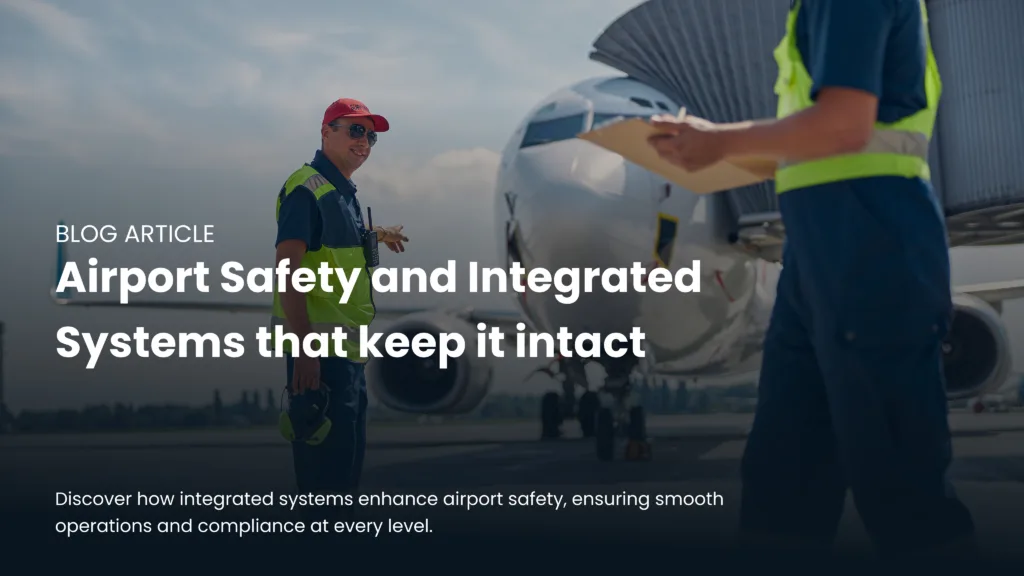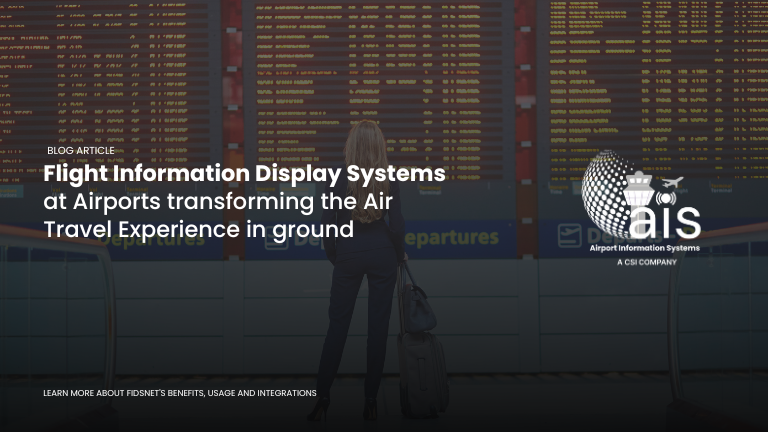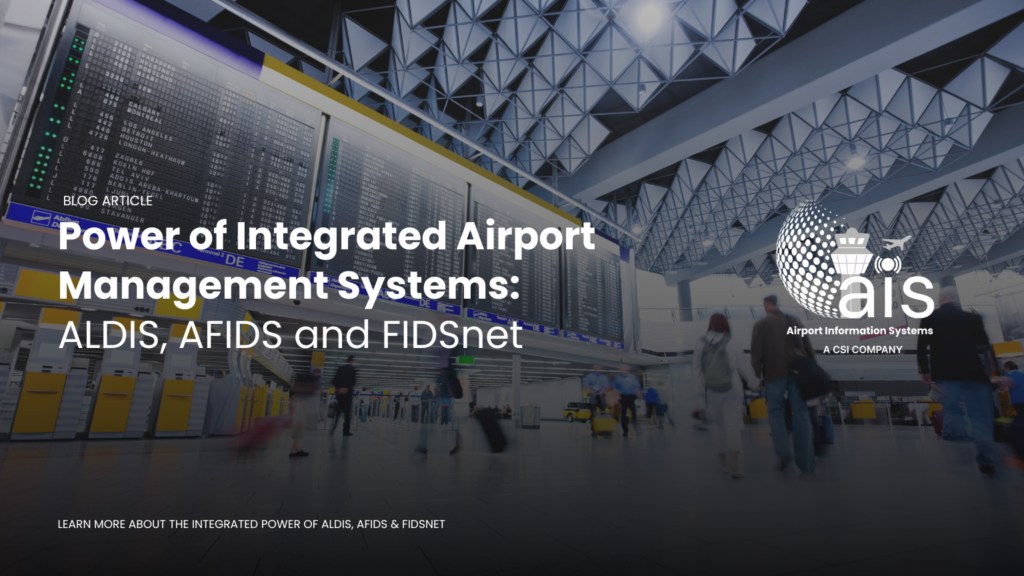Airport safety remains one of the most critical priorities in global aviation, especially as air travel continues to rebound and expand. IATA projects that by the end of 2025, global air passenger numbers will reach 5.2 billion, outpacing pre-pandemic levels. This sharp growth places immense operational and regulatory pressure on airports worldwide. A single lapse, whether it occurs on the ground or within a system, can trigger delays, financial repercussions, or put lives at risk.
Although physical security measures, such as perimeter fencing and runway inspections, continue to play a key role, they represent just one layer of protection. At the operational level, safety now hinges on how accurately data is managed, how efficiently information flows between systems, and how clearly passengers are kept informed during every stage of their journey.
This blog examines the foundational pillars of airport safety and how intelligent, integrated technologies help airports enhance safety across all operational areas.
Key Pillars of Aviation and Airport Safety
Airport safety is not confined to just one system or department. It spans infrastructure, daily operations, technology, and emergency response. Thus, ensuring airport safety requires a layered, multi-dimensional approach. Below are four critical areas that collectively shape the safety standards of any modern airport.
Key pillars that uphold airport safety | Credit: ChatGPT
1. Physical Safety
Runways, taxiways, terminal buildings, and access points must be secured and maintained to exacting standards. This includes the use of surveillance systems, proper lighting, and visible ground markings. Any oversight in these areas can lead to delays or elevate the risk of ground incidents.
2. Operational Safety
Flight coordination, aircraft tracking, and ground support scheduling must run precisely to plan. Errors or gaps in communication, especially in aircraft movement logs, can result in gate conflicts, cascading delays, or non-compliance with aviation regulations.
3. Cybersecurity and Airport Safety
Airports increasingly depend on digital systems to manage everything from billing to flight data and passenger services. As interconnectivity grows, so does the risk of cyber threats. Attacks targeting critical software can disrupt services, breach sensitive information, and directly impact the airport’s ability to function safely.
4. Emergency Preparedness
No safety system is complete without a backup plan for the unexpected. Airports must be equipped to handle technical faults, fire hazards, medical emergencies, and adverse weather conditions. Achieving this requires cross-department coordination, real-time alert systems, and clear communication with external emergency services.
These pillars form the foundation of safe airport operations. Therefore, understanding how they work together is the first step toward building a safer, more efficient airport.
The Role of Technology in Enhancing Airport Safety
Manual procedures struggle to keep up with the pace, scale, and precision required in modern airport operations. Tasks such as tracking aircraft movement, managing gate assignments, or updating flight information involve high volumes of time-sensitive data that are prone to delays and human error when handled manually. Systems like Airport Operational Databases (AODB), Gate Management Systems, and integrated Flight Information Display Systems (FIDS) help bridge this gap by automating repetitive tasks, reducing the chances of mistakes, and offering real-time operational visibility.
A well-integrated digital infrastructure can synchronise flight data, passenger flows, and billing systems across departments. It supports instant alerting mechanisms, enables predictive maintenance of ground equipment, and helps airport teams make faster, data-driven decisions during disruptions.
Advanced display systems like FIDSnet also contribute by improving passenger awareness, minimising crowding, and supporting smoother movement throughout terminals. In addition, accurate data logging and automated audit trails simplify compliance reporting and reduce the time needed to investigate operational incidents.
Instead of reacting to safety issues after they occur, systems like real-time surveillance, alerting dashboards, and predictive maintenance tools help airports detect problems early and take preventive action. As a result, teams can sustain safe operations even during high-pressure situations.
How AIS’ Solutions Elevate Airport Safety?
Keeping an airport safe goes beyond what’s visible on the runway or in the terminal. It also depends on how well the systems behind the scenes handle data, be it flight tracking, billing accuracy, or passenger communication. Airport Information Systems (AIS) offers purpose-built solutions that contribute directly to these needs. Moreover, AIS’ solutions are already trusted by over 30 international airports to reduce operational errors, improve response times, and maintain safety.
ALDIS – Aeronautical Billing System
Billing might not seem like an obvious area connected to safety. But, errors in invoicing or flight data records can trigger disputes, loss of revenue, or audit complications, all of which can slow down operations.
ALDIS addresses this by capturing verified flight movement and service data directly from AIS’s real-time processing engine (AFIDS). It automatically calculates landing fees, parking charges, fuel usage, de-icing, and other service costs with precision. In addition, the system is fully aligned with ICAO, IATA, and UK CAA billing standards, and supports multi-currency invoicing, surcharges, and incentive schemes.
It also includes built-in audit trails and a comprehensive reporting toolkit. These features help airport teams extract accurate records of flight activity, runway usage, and service logs, which are critical when reviewing incidents or presenting compliance documentation.
Real-Time Flight Data Management with AFIDS
Airport Flight Information Data System (AFIDS) acts as the core data engine behind AIS tools, feeding real-time inputs into both billing and display systems. It supports Air Traffic Control Admin, handling agents, refuellers, and operations teams with accurate records of block on/off times, fuel usage, runway assignments, circuits, service logs, and more.
The ATC module links with AFTN data feeds, covering flight plans, slot requests, runway usage, and actual arrival or departure times, while providing mandatory reports for entities like NATS or CAA. Real-time data from AFIDS also powers ALDIS billing accuracy and FIDSnet flight displays, ensuring operational safety starts at the data source.
FIDSnet – Flight Information Display System
Real-time flight information is a key part of airport safety. In crowded terminals, unclear or delayed updates can lead to congestion, confusion, and even missed emergency instructions.
FIDSnet pulls live data from AFIDS and pushes accurate updates to screens across the airport, from gate areas and check-in counters to lounges and exit zones. It supports multiple screen zones, vertical formats, multilingual output, and can instantly display emergency alerts when needed.
The system includes a user-friendly layout editor and template manager, making updates quick and consistent. Moreover, uptime is monitored remotely to ensure screens remain active, and during disruptions, display content can be overridden to show critical safety messages.
TL;DR: Airport Safety Demands Smart, Integrated Systems
Airport safety is a multi-layered responsibility that spans physical security, operational coordination, digital protection, and emergency readiness. As manual processes fall short in managing today’s volume and complexity, solutions like automated billing engines and real-time flight display systems have become central to improving accuracy, speed, and control. Especially, integrated digital infrastructure supports real-time data sharing, predictive maintenance, and faster response during disruptions.
AIS’s solutions are built with this in mind. ALDIS ensures billing accuracy and audit readiness by using verified flight data, helping reduce errors and disputes. AFIDS acts as the central data engine, collecting and distributing real-time flight movement and service data across departments, ensuring consistency and operational visibility. In addition, FIDSnet improves situational awareness by delivering timely, consistent flight updates to passengers and staff across the terminal. Airports that invest in intelligent, connected tools are better equipped to meet today’s demands while building resilience for tomorrow.
Operational safety starts with the right systems in place. Try AIS’s integrated airport systems.


